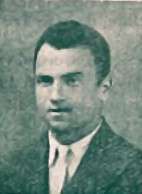Szymon Datner
Szymon Datner (Kraków, 2 February 1902 – 8 December 1989, Warsaw) was a Polish historian, Holocaust survivor and underground operative from Białystok,[1] best known for his studies of the Nazi war crimes and events of The Holocaust in the Białystok region. His 1946 Walka i zag/ada bialostockiego ghetta was one of the first studies of the Białystok Ghetto.[2]

Life to 1945
In 1928 Datner settled in Białystok.[3] Before the outbreak of World War II, he worked as a physical-education teacher at a Jewish secondary school in Białystok. He lived in that city with his wife and two daughters through the Soviet occupation of eastern Poland. After the German attack on the Soviet Union, he was forced with his family into the Białystok Ghetto. On 24 May 1943 he helped smuggle several persons out of the Ghetto. However, his wife and daughters did not survive its liquidation.
Postwar career
After the war, Datner served for two years as head of the Białystok branch of the Central Committee of Jews in Poland (CŻKH). "A survivor himself, he deposited his own testimony at the Jewish Historical Commission in Białystok on 28 September 1946."[4]
The same year, the CŻKH published his Walka i zagłada Białostockiego Ghetta (The Struggle and Destruction of the Białystok Ghetto).[3] In the late 1940s Datner moved to Warsaw. He became a prominent specialist on World War II crimes and the Holocaust.[4] Of Jewish extraction, he was dismissed from his post during the 1968 Polish political crisis but was rehabilitated soon after.
In 1969–70 he presided over Warsaw's Jewish Historical Institute, and he was one of the historians at the Main Commission to Investigate Hitlerite Crimes.[5] According to Bernd Wegner, Datner drew up the most comprehensive documentation of Nazi Germany's war crimes and atrocities in eastern Poland.[6] In 1966 he published an article on "The Extermination of the Jewish Population in the District of Bialystok" (mentioning, among others, the Jedwabne pogrom); however, due to censorship in the Polish People's Republic he could not openly write on killing of Jews by Poles.[4][7]
Death
Datner died in 1989 in Warsaw and was interred at the Okopowa Street Jewish Cemetery.
Publications
- Walka i Zagłada białostockiego getta (Łódź, 1946)
- Zbrodnie Wehrmachtu na jeńcach wojennych w II wojnie światowej (Warsaw, 1961)
- Zbrodnie okupanta w czasie powstania warszawskiego w 1944 roku (w dokumentach) (Warsaw, 1962)
- Wilhelm Koppe - nieukarany zbrodniarz hitlerowski (Warsaw-Poznań, 1963)
- Ucieczki z niewoli niemieckiej 1939-1945 (Warsaw, 1966)
- Eksterminacja ludności żydowskiej w Okręgu Białostockim (Bulletin of the Jewish Historical Institute, Warsaw, October–December 1966, no. 60: pp. 3–29)
- Niemiecki okupacyjny aparat bezpieczeństwa w okręgu białostockim (1941–1944) w świetle materiałów niemieckich (opracowania Waldemara Macholla), Biuletyn GKBZH (Warsaw, 1965)
- 55 dni Wehrmachtu w Polsce (Warsaw, 1967)
- Las sprawiedliwych. Karta z dziejów ratownictwa Żydow w okupowanej Polsce ( Warsaw, 1968)
- Tragedia w Doessel - (ucieczki z niewoli niemieckiej 1939-1945 ciąg dalszy) (Warsaw, 1970)
- Z mądrości Talmudu (Warsaw, 1988)
References
- Grabowski, Jan (2013). Hunt for the Jews: betrayal and murder in German-occupied Poland. Bloomington, Indiana: Indiana University Press. ISBN 978-0-253-01087-2.
- Aleksiun - 2004 - Polish Historiography of the Holocaust—Between Silence and Public Debate.pdf, retrieved 2018-01-29
- Poczykowski, Radosław & Katarzyna Niziołek. "Szymon Datner (1902-1989)". Szlak Dziedzictwa Żydowskiego w Białymstoku. Uniwersytet w Białymstoku. Retrieved 10 May 2011.
- Wróbel, Piotr (2006). "Polish-Jewish Relations". Dagmar Herzog: Lessons and Legacies: The Holocaust in international perspective. Northwestern University Press. pp. 391–96. ISBN 0-8101-2370-3. Retrieved 10 May 2011.
- "Datner o zbrodniach hitlerowskich na Żydach zbiegłych z gett - Muzeum Historii Polski". muzhp.pl.
- Bernd Wegner (1997), From Peace to War: Germany, Soviet Russia, and the World, 1939-1941, Militärgeschichtliches Forschungsamt, Berghahn Books, Germany, p. 54
- Bender, Sara (2015). "Not Only in Jedwabne: Accounts of the Annihilation of the Jewish Shtetlach in North-eastern Poland in the Summer of 1941". Holocaust Studies. 19 (1): 1–38. doi:10.1080/17504902.2013.11087369. Retrieved 2018-06-25.
External links
- Datner, Szymon. "German Nazi Crimes Against Jews Who Escaped From The Ghettoes "Legal" Threats And Ordinances Regarding Jews And The Poles Who Helped Them" (PDF). Jewish Historical Institute Bulletin No. 75 (1970).